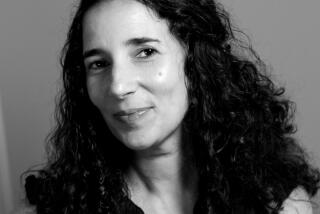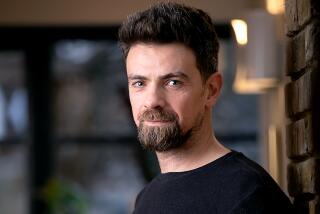Sons of Mother History : CHILDREN OF THE ARBAT <i> by Anatoli Rybakov; translated by Harold Shukman (Little, Brown: $19.95; 686 pp.) </i>
- Share via
It may well be that the enormity of a modern tyrant’s crimes can only be expressed through metaphor. Not long ago, the Soviet Georgian film maker, Tengiz Abuladze, did this in his surrealistic film “Repentance.” Reading Anatoli Rybakov’s “Children of the Arbat,” which traces for nearly 700 pages a dozen Soviet destinies carefully observed and skillfully interwoven, we long for metaphors that would do justice to the memory of the millions who died at Joseph Stalin’s hands. The unadorned banality of evil in our century robs us of the benefit of catharsis. Only a very few writers have been able to deal with this banality successfully, and usually in the form not of fiction but of recollections of experience--Primo Levi’s autobiography, Tadeusz Borowski’s “This Way for the Gas, Ladies and Gentlemen,” Alexander Solzhenitsyn’s “The GULAG Archipelago.” “Doctor Zhivago” remains the memorable exception, a realistic novel by one of the great poets of the century who tried his hand at fiction late in life and created an epic, flawed perhaps, but a true epic nonetheless.
The strength of “Children of the Arbat” lies in the honesty with which it depicts daily life in the Soviet Union in the late 1920s and early 1930s. Under the sign of glasnost , Rybakov, now 77, participates in the urgent task facing Soviet writers today--acquainting their readers with their own past and that of their fathers and grandfathers.
“Children of the Arbat” covers events that led to Stalin’s Great Purges, heralded by the murder, in 1934, of Leningrad Party chief Sergei Kirov. The Soviet poet Yevgeny Yevtushenko has had high praise for Rybakov, whose earlier book, “Heavy Sand,” published in this country in 1981, speaks compassionately of the fate of Jews in the Ukraine during the German occupation: “Rybakov is the man to do this (tell the truth about the ‘30s). He is old enough to be a witness to that time. Mother History chose him. After this, it will be impossible to have the same history books in our libraries and schools.”
In his novel, Rybakov chronicles the lives of a group of young Muscovites and their families who live in the heart of the capital at 51 Arbat St. (Rybakov’s actual childhood address), an apartment building with a facade of white glazed tiles, typical of thousands of others throughout the city. Sasha Pankratov is Rybakov’s hero, an impulsive, warm-hearted young Komsomol (Communist Youth League) activist who is unjustly arrested and sent to exile in Siberia. His life there is recorded with greater candor than is usual in Soviet literature, though there is little that will be new to readers of Evgenia Ginzburg and Solzhenitsyn. Sasha’s antagonist is Yuri Sharok, a scheming womanizer with a sadistic streak, who becomes a police informer and then an operative for the NKVD, a predecessor of today’s KGB.
Within the novel, a secondary plot involves Stalin as he asserts his power over the Soviet Union after Lenin’s death. The lieutenants surrounding him are drawn convincingly enough, men like Andrei Zhdanov and Sergei Kirov. It is the latter’s death, most probably ordered by Stalin himself, that ushers in “the dark ages ahead,” foretold at the end of the book--the colossal terror which is about to engulf the country.
“Children of the Arbat” is quintessential Socialist Realism, a novel of the post-Stalin era akin to Vasily Grossman’s “Time and Fate,” in which Stalinism and Hitlerism are equated by an author who was to be hounded by enraged Soviet officials for having dared to make the equation. A meeker book than Grossman’s, which confronts the evil inherent in dictatorship more directly, “Children of the Arbat” is the first of the two to come out in the Soviet Union.
Publication of the book is being credited to Mikhail Gorbachev and glasnost . It may also be seen, however, as a belated offspring of Khrushchev’s Thaw. As long ago as 1967, Alexander Tvardovsky announced its publication in the magazine Novy Mir, in which he had once published Solzhenitsyn’s “One Day in the Life of Ivan Denisovich,” the epoch-making novella about life in a Stalinist labor camp. By then, however, the Thaw had given way to a new freeze, Brezhnev’s “era of stagnation,” and the book was not published after all.
Twenty years later, in 1987, “Children of the Arbat” was serialized in three parts in another Soviet literary journal, Druzhba Narodov (Friendship of the Peoples). When Rybakov was in the United States in the spring of 1986, some months before the policy of openness became official in the Soviet Union, he spoke about his novel with Herbert Mitgang, cultural correspondent of The New York Times: “I think the signs are favorable (for the publication of ‘Children of the Arbat’). I believe it can have a strong impact among readers in Russia. I’m convinced the outcome will be positive for publication,” he said, adding, “ My people need this novel, my country needs this novel. It should be published at home first.” And it was. “Children of the Arbat” is now accessible to millions of Soviet readers eager to learn the truth about their country’s past. Mother History was given her due at last.
Indeed the recent lifting of censorship, partial as it may be, is a crucial step for the survival of Russian culture, debilitated by 70 years of silence and lies. It is one of the most far-reaching and boldest of Gorbachev’s policies. Ably translated into English by Harold Shukman, “Children of the Arbat” offers a vivid insight into the literary situation in the Soviet Union today. Writers like Rybakov still see themselves as “engineers of the human soul,” as they were enjoined to be by Maxim Gorky, the father of Socialist Realism. They set themselves the task of educating their readers and enlightening them in ways that to us may at times seem simplistic. Nonetheless the publication of this novel, which captures the flavor of life in Moscow 50 years ago, is a liberalizing, welcome political act on the part of the present Soviet leadership.
More to Read
Sign up for our Book Club newsletter
Get the latest news, events and more from the Los Angeles Times Book Club, and help us get L.A. reading and talking.
You may occasionally receive promotional content from the Los Angeles Times.








